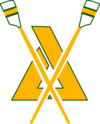All about the boats!
The Single Scull(1x): Your Most Honest Teammate
A single scull is typically 24–27 feet long and weighs around 14kg(30 lbs), which means it’s long enough to look like a javelin and light enough that a strong breeze might just carry it away.
Without question, rowing a single is like staring into a performance mirror. Every stroke reflects exactly what’s working and what’s… not. No teammates to blame, no excuses. Just you, your technique, and possibly a slight existential crisis.
Top Tip: NEVER Let Go of Your Handles! (Unless, of course, you’d like an unexpected swimming lesson.)
The Double (2x): Twice the Rowers, Twice the Fun
A double scull is typically 32–34 feet long and weighs around 27kg (60 lbs). It’s like a single scull, except now you have someone to blame when things go wrong.
In a double, both rowers have two oars each. You’re expected to be perfectly in sync, but let’s be real, sometimes it feels more like a chaotic three-legged race on water.
Seat Wars: Bow vs. Stroke
Stroke Seat (back of the boat): The pace-setter, the rhythm master, the one who pretends they have everything under control.
Bow Seat (front of the boat): The steerer, the strategist, and the only one allowed to turn around and give "helpful feedback" (read: backseat rower).
Top Tip: Learn to Read Minds
If you and your partner don’t communicate well, one of you is going to get a surprise workout in "emergency steering" while the other wonders why the boat is veering into the reeds.
The Pair (2-): The Ultimate Relationship Test
A coxless pair is about 32–35 feet long and weighs roughly 27-32kg (60–70 lbs). Unlike a double, you only get one oar each, which means you only have control over half the power and half the balance. Your power must match your partner’s for the boat to go straight, and a little trust helps too…
A bad pair partner will make you question your life choices. A good pair partner will make you feel like you have one brain, two bodies, and the smoothest, most effortless rhythm imaginable
Seat Wars: Bow vs. Stroke
Stroke Seat: Dictator of rhythm. If they rush the slide, you’re both doomed.
Bow Seat: The boat’s only steering system. If they mess up, you're both getting an unplanned tour of the shoreline.
Top Tip: Choose Your Partner Wisely
The pair is known as the "Divorce Boat" for a reason. Row with someone you can communicate clearly with, otherwise, you’ll both be training for a future in synchronized swimming.
The Quad (4x): Rowing’s Version of a Fast and Furious Getaway Car
A quadruple scull (quad) is about 39–42 feet long and weighs roughly 50-54kg (110–120 lbs). Unlike smaller boats, the quad gives you more power, more speed, and slightly less fear of capsizing.
Why is the Quad So Great?
Four rowers, eight oars = Maximum speed with fewer stability issues.
Less blame per person = If something goes wrong, you can just glare at the person in front of you and pretend it wasn’t you.
Best of both worlds = More power than a double, but not as unwieldy as an eight.
Seat Wars: Who's in Charge Here?
Stroke Seat (#4) – The fearless leader. Sets the rhythm. If they mess up, everyone messes up. No pressure!
Engine Room (#2 and #3) – The powerhouses. Less responsibility, more brute force. If you’re here, just pull hard and don’t ask questions.
Bow Seat (#1) – The steerer, the strategist, and the only one who has to think. Listen to your Bow Seat!
Top Tip: Synchronize or Suffer
Nothing is more chaotic than a quad where everyone rows at their own tempo. If you’re out of sync, the boat will lurch, the oars will clash, and you’ll all look like a drunken caterpillar.
The Eight (8+): The Ultimate Speed Machine
An eight is 54–60 feet long, weighs around 90-100kg (200–220 lbs), and is the fastest boat on the water. It’s also the most complicated—because now, you need eight people to row as one flawless machine (or at least try).
Why is the Eight So Iconic?
Ridiculous speed – When done right, the eight flies.
A coxswain! – Finally, someone else to steer and yell at you, so you can focus on rowing (or ignoring their instructions).
Pure teamwork – In an eight, there is nowhere to hide. If someone’s out of sync, everyone knows it.
Seat Wars: Who’s Doing What?
Stroke Pair (#8 ) – The tempo master, setting the pace for all eight rowers. If they rush, everyone rushes. If they’re calm, no one listens. Sometimes has an ego
The Engine Room (#3–6) – The absolute unit zone of the boat. These are often the strongest rowers, there to provide raw power. No thinking required, just pull.
Bow Pair (#2 & #1) – The finesse rowers. Responsible for balancing the boat and making sure the eight doesn’t wobble like a giant, angry canoe.
The Coxswain – Tiny, loud, and 100% in control. Keeps the boat straight, calls the race strategy. Definitely has an ego
Top Tip: Trust the Coxswain
Your cox might be 5 feet tall and weigh as much as a backpack, but they are in charge. Listen to them, follow their calls, and resist the urge to backseat-drive (or backseat-row).
Weight Matters (Sorry, We Had to Ask)
Normally, asking someone’s weight is a one-way ticket to trouble, but in rowing, it’s essential! The right boat size ensures optimal performance and stability:
Boat too light for the crew? You’ll feel like you're dragging an anchor.
Boat too heavy for the crew? You’ll bounce around like a cork in a storm.
DDRC club boats are listed by weight class, with ranges of the best average crew weight so choose wisely:
Lightweight (Small Frame) – 52–75 kg (115–165 lbs)
Midweight (Medium Frame) – 73–86 kg (160–190 lbs)
Heavyweight (Large Frame) – 86–102+ kg (190–225+ lbs)
Find your match, grab your oars, and enjoy the ride! (Or, at the very least, try to stay in the boat.)






